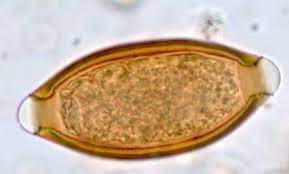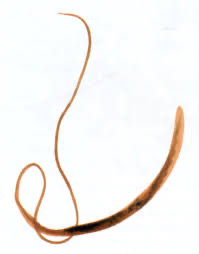
 Trichuris trichiura, Trichocephalus trichiuris or whipworm, is a parasitic roundworm helminth that causes trichuriasis.
Trichuris trichiura, Trichocephalus trichiuris or whipworm, is a parasitic roundworm helminth that causes trichuriasis.
Trichuriasis is a type of helminthiasis which is one of the neglected tropical diseases that can infect the large intestine.
It is commonly known as the whipworm which refers to the shape of the worm.
The female T. trichiura produces 2,000–10,000 single-celled eggs per day.
Eggs are deposited from human feces to soil where, after two to three weeks, they become embryonated and enter the infective stage.
These embryonated infective eggs are ingested by hand-mouth or through fomites and hatch in the human small intestine.
The eggs use the intestinal microflora as a stimulus to hatching, and the intestine is the location of growth and molting.
The infective larvae develop in the small intestine.
The young worms move to the cecum and penetrate the mucosa, and there they complete development as adult worms in the large intestine.
The life cycle from the time of ingestion of eggs to the development of mature worms takes approximately three months.
The female T. trichiura begin to lay eggs after three months of maturity.
Worms commonly live for about one year, during which time females can lay up to 20,000 eggs per day.
It is a roundworm that infects the intestines.
Trichuris trichiura lives in the soil in its egg stage.
Once it is ingested, it develops into the larvae stage, finally maturing into the adult stage in the intestines.
Two quantitative trait loci on chromosome 9 and chromosome 18 may be responsible for a genetic predisposition or susceptibility to infection of T. trichiura by some individuals.
Trichuris trichiura has a narrow anterior esophageal end and shorter and thicker posterior end.
They are pinkish-white worms are threaded through the mucosa.
They attach through their slender anterior end and feed on tissue secretions instead of blood.
Females are larger than males; approximately 35–50 mm long compared to 30–45 mm.
The females have a bluntly round posterior end compared to their male counterparts.
Their characteristic eggs are barrel-shaped and brown, and have bipolar protuberances.
Trichuriasis, whipworm infection, occurs through ingestion of whipworm eggs and is more common in warmer climates.
Whipworm eggs are passed in the feces of infected persons, and if an infected person defecates outdoors or if untreated human feces is used as fertilizer, eggs are deposited on soil where they can mature into an infective stage.
Ingestion of these eggs can occur when hands or fingers that have contaminated dirt on them are put in the mouth or by consuming vegetables or fruits that have not been carefully cooked, washed or peeled.
The eggs hatch in the small intestine, then move into the wall of the small intestine and develop.
On reaching adulthood, the thinner anterior end of the worm burrows into the large intestine.
The thicker posterior end projecting into the lumen, where it mates with nearby worms.
The females can grow to 50 mm (2.0 in) long.
Trichuris trichiura can cause the Trichuris dysentery syndrome (TDS), with chronic dysentery, anemia, rectal prolapse, and poor growth.
Whipworm commonly infects patients also infected with Giardia, Entamoeba histolytica, Ascaris lumbricoides, and hookworms.
Treatment
TDS is treated with anthelminthics as well as iron supplementation for anemia.
Trichuris trichiura can be treated with a single dose of albendazole.
Other treatments that can be used is mebendazole, or flubendazole.
Emodepside has clinical activity.
The drugs interferes with the parasite’s nutrient intake, which eventually leads to death.
There is a worldwide distribution of Trichuris trichiura, with an estimated 1 billion human infections.
It is chiefly tropical, especially in Asia and, to a lesser degree, in Africa and South America.
Within the United States, infection is rare overall but may be common in the rural Southeast, where 2.2 million people are thought to be infected.
Poor hygiene is associated with trichuriasis as well as the consumption of shaded moist soil, or food that may have been fecally contaminated.
Children are especially vulnerable to infection due to their high exposure risk.
Eggs are infective about 2–3 weeks after they are deposited in the soil under proper conditions of warmth and moisture, hence its tropical distribution.
A closely related species, Trichuris suis, which typically infects pigs, is capable of infecting humans.
